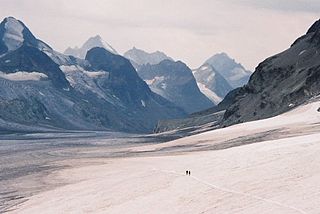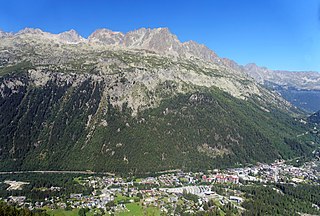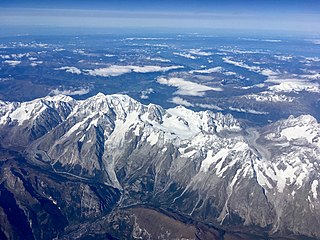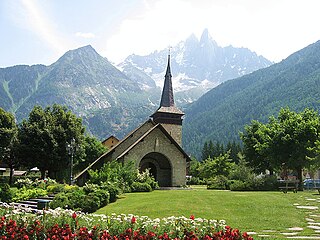
Haute-Savoie is a department in the Auvergne-Rhône-Alpes region of Southeastern France, bordering both Switzerland and Italy. Its prefecture is Annecy. To the north is Lake Geneva; to the south and southeast are Mont Blanc and the Aravis mountain range.

Chamonix-Mont-Blanc, more commonly known as Chamonix, is a commune in the Haute-Savoie department in the Auvergne-Rhône-Alpes region of southeastern France. It was the site of the first Winter Olympics in 1924. In 2019, it had a population of 8,640.

The Haute Route is the name given to a route undertaken on foot or by ski touring between the Mont Blanc in Chamonix, France, and the Matterhorn, in Zermatt, Switzerland.

Les Houches is a commune in the Haute-Savoie department in the Auvergne-Rhône-Alpes region of Eastern France. In 2017, it had a population of 2,943.

Argentière is a picturesque skiing, alpine walking and mountaineering village in the French Alps, part of the commune of Chamonix-Mont-Blanc, at an altitude of 1,252 m (4,108 ft).

Les Contamines-Montjoie is a commune in the Haute-Savoie department in the Auvergne-Rhône-Alpes region in south-eastern France.

The Mont Blanc massif is a mountain range in the Alps, located mostly in France and Italy, but also straddling Switzerland at its northeastern end. It contains eleven major independent summits, each over 4,000 metres (13,123 ft) in height. It is named after Mont Blanc, the highest point in western Europe and the European Union. Because of its considerable overall altitude, a large proportion of the massif is covered by glaciers, which include the Mer de Glace and the Miage Glacier – the longest glaciers in France and Italy, respectively.

The Tour du Mont Blanc or TMB is one of the most popular long-distance walks in Europe. It circles the Mont Blanc massif, covering a distance of roughly 165 kilometres (103 mi) with 10 kilometres (6.2 mi) of ascent/descent and passing through parts of Switzerland, Italy and France.

The Saint-Gervais–Vallorcine railway, also known as the Saint-Gervais–Vallorcine Line, is a single-track 36.5 km (22.7 mi) long metre gauge railway in France connecting the SNCF's Saint-Gervais-les-Bains-Le Fayet station with Vallorcine station and the border with Switzerland through Chamonix. Opened in stages between 1901 and 1908 by the Chemins de fer de Paris à Lyon et à la Méditerranée (PLM), it is part of the main SNCF network as far as Vallorcine. To Le Châtelard is run by the Swiss company Transports de Martigny et Régions (TMR), which also operates the Martigny–Châtelard Railway.
The Aiguilles Rouges are a crystalline mountainous massif of the French Prealps, opposite the Mont Blanc Massif. The colour of the iron rich gneiss (metamorphique) mountains gives the range its name. The highest summit is the Aiguille du Belvédère at 2,965 metres (9,728 ft). At the southern end of the range, Le Brévent at 2,525 metres (8,284 ft) is accessible by a cable car in the Planpraz and the Brévent sections.
The Arve Valley is an alpine valley located in the French Haute-Savoie department. The namesake of the valley is the river at the bottom: the Arve. The valley as a whole makes up the majority of Faucigny, one of the Natural Regions of France, and one of six that make up the Savoie region.

Col des Montets is a mountain pass in the French Alps in the Haute-Savoie department of France. It is on the road between Chamonix, the Swiss Col de la Forclaz and Martigny in the canton of Valais, Switzerland.

Mary Isabella Charlet-Straton was a British female mountain climber. She made several first ascents in the Alps with Emmeline Lewis Lloyd as well as the first winter ascent of Mont Blanc with her future husband Jean Charlet in January 1876. The peak Pointe Isabella was named in her honour after she had taken part in its first ascent.

Les-Praz-de-Chamonix is a mountain village in the French Alps, part of the commune of Chamonix. Altitude: 1060 m (3477 ft.).

Vallorcine is a commune in the Haute-Savoie department in the Auvergne-Rhône-Alpes region in southeastern France. In 2018, it had a population of 404.

The Argentière Hut is a refuge in the Mont Blanc massif in the Alps. Built in 1974 by the Club Alpin Français, it is located above the north bank of the Argentière Glacier in France at an altitude of 2,691 meters above sea level.

Aiguille du Belvédère is a mountain of Haute-Savoie, France. It is the highest peak in the Aiguilles Rouges range of the French Prealps and has an altitude of 2,965 metres (9,728 ft) above sea level.

The Aiguille du Chardonnet is a mountain in the Mont Blanc massif in Haute-Savoie, France. It lies between the Glacier du Tour and the Argentière Glacier. The border with Switzerland runs just east of the summit. The East or Forbes Arete provides a popular and classic mountaineering route to the summit.
The Passy National Nature Reserve is a nature reserve located on the face of the Aiguilles Rouges and Mont Blanc mountain ranges, in the middle of the Arve valley, in the Haute-Savoie metropolitan department of France.

The Marathon du Mont Blanc is an annual marathon distance (42.195 km) alpine trail running event held in Chamonix, France. The Marathon du Mont Blanc race is the titular event but the name also refers to the group of longer and shorter distance races one or more of which competitors can compete in over a three-day period starting on the last Friday in June.


















